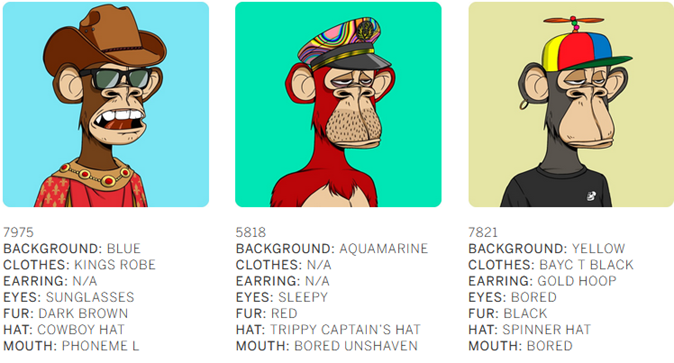What are NFTs (legally)?
Whether you are into new technologies, arts or simply following the news, you have almost certainly heard this acronym. NFTs seem to be everywhere and sometimes are sold for amounts beyond most people’s understanding. Sothebys for instance has sold a collection of 101 Bored Apes for an amount of over USD 24 million.

Unfortunately, simple explanations on non-fungible tokens are hard to come by. Admittedly, this is a relatively sophisticated concept. The aim of these lines is to popularize the subject. However, you should have some rudimentary knowledge of distributed ledger technology – DLT “. In particular, it will be useful for you to have a good understanding of (i) the decentralized and unforgeable nature of the “blockchain“, (ii) the consensus algorithm and (iii) traceability of transactions.
A copy of digital art?
NFTs are tokens that run on various blockchains, including Ethereum Polygon, Binance smart chain (BSC) and Avalanche. The blockchain thus enables NFTs to be exchanged around the world with relative ease. Unlike cryptocurrencies, NFTs are unique (i.e. non-fungible).
NFTs are often used as a medium for digital graphic art, but it’s also possible for an NFT to exchange a video, a music album or even video game elements. In fact, human inventiveness seems to be the only limit to the use of NFTs. For the sake of brevity, we’ll confine our discussion here to NFTs related to the art world.
We often hear that buying an NFT is the digital equivalent of buying an artist’s canvas. However, this analogy is flawed in more ways than one. The most obvious practical difference is the ease with which digital content can be duplicated. But that’s by no means the only difference.
The sale or purchase of an NFT does not require the existence of any content (artistic or otherwise). NFTs are non-fungible simply by virtue of being numbered. It is possible to create a series on the blockchain, limited, for example, to 10,000 numbered tokens, and to sell them in this form only. It will be possible to purchase tokens 66 out of 10,000 in the collection, which are distinct from tokens 65 or 67. In other words, the token represents a position on the blockchain, which is not necessarily linked to content.
The graphic, musical or audiovisual content associated with the NFT is only a representation of it. In other words, the buyer only buys a token, not its representation. This means that unless there is a contractual basis, the buyer has no rights whatsoever over the art form representing the NFT he is purchasing, except for a right of access.
What are the buyer’s rights?
There is no uniformity in the rights conferred on the holder of an NFT. At the very least, the owner of the NFT can access it in his or her ” crypto-asset ” wallet. For the rest, the rights of purchasers of NFTs will depend on the contractual relationship between the purchaser, the entity that created the NFT (” minting the NFT “) and, where the copyright does not belong to the latter, the author of the work.
As explained above, the transfer of an NFT does not imply the transfer of copyright. This is not usually the case. Worse still, NFT exchange platforms (e.g. https://opensea. io/tos ) do not guarantee that the NFTs viewable on the platform do not infringe the intellectual property rights of a third party[1].
Yuga Labs LLC (the copyright holder for Bored Apes) stipulates in its terms and conditions that owners of these NFTs are granted a license for personal and commercial use. Perhaps this explains part of the appeal of these NFTs.
Conversely, it seems that CryptoPunks holders do not enjoy such licenses, and there is great uncertainty as to the extent of their rights[2].
In conclusion, it is necessary to consult the general terms and conditions of the company that created the NFTs you are interested in to find out the extent of the rights conferred on the owners of said NFTs.
What is the basis for the value of NFTs?
This is the question to which it is impossible to give a definitive answer. I would argue, for NFTs related to the art world, that these are the rights described above in conjunction with the scarcity of NFTs (as well as the speculation engendered by scarcity). With so many celebrities holding NFTs from the most famous collections, isn’t there a certain prestige in being part of the same club, limited to 10,000 members, as Eminem, Stephen Curry, Jimmy Fallon or Neymar?
Conversely, the rarity of NFTs is unfortunately difficult to assess. Of course, collection designers commit to including a certain number of NFTs in their collections, but it’s not clear how far this commitment extends. Even if this commitment is respected, nothing prevents designers from creating a new collection, similar to the previous one, thus diminishing its value. After all, don’t promises only bind those who believe them?
NFTs open up a world of possibilities thanks to their revolutionary technology. Given the investment they can represent and their wide variety, some research should be in order for cautious digital art fans.
At the dawn of the metaverse, will the value of NFTs continue to rise, or are we on the verge of a speculative bubble? I leave it to each reader to make up his or her own mind.
[1] Conversely, it is the user who guarantees opensea.io that the uploaded content respects the intellectual property of others.
[2] For more information on CryptoPunks and Bored Apes rights: https: //decrypt.co/88041/cryptopunks-ip-complaints-punk4156-10m-ethereum-nft-sale

